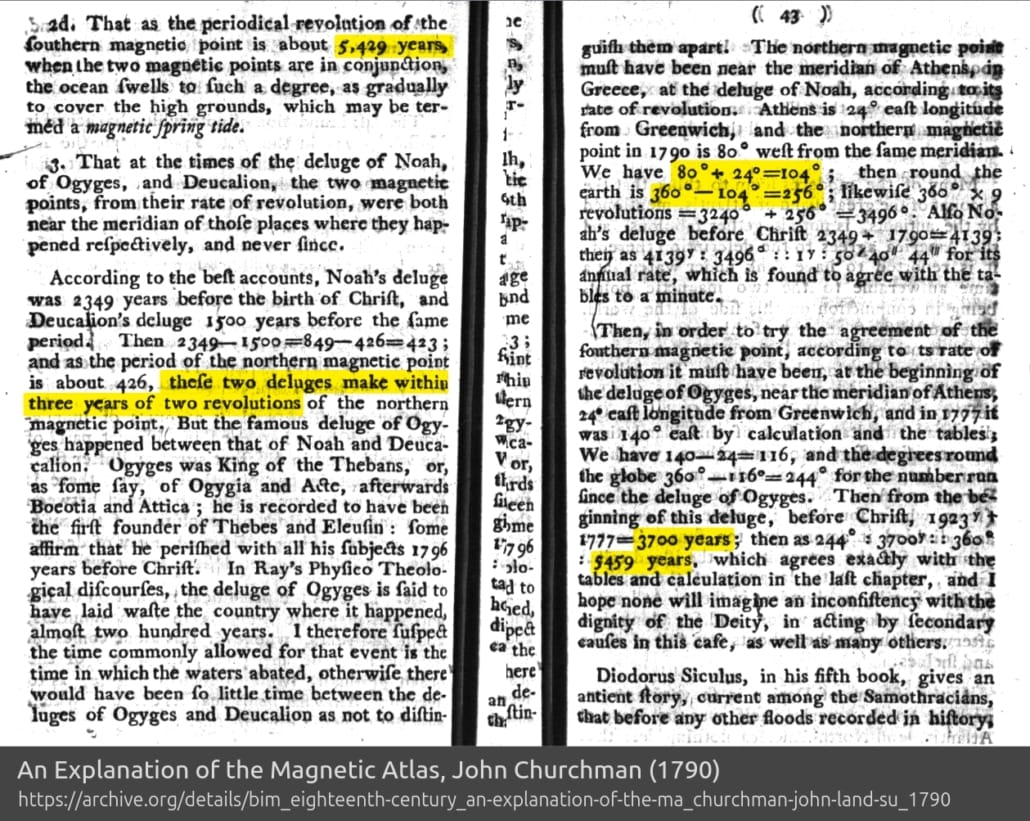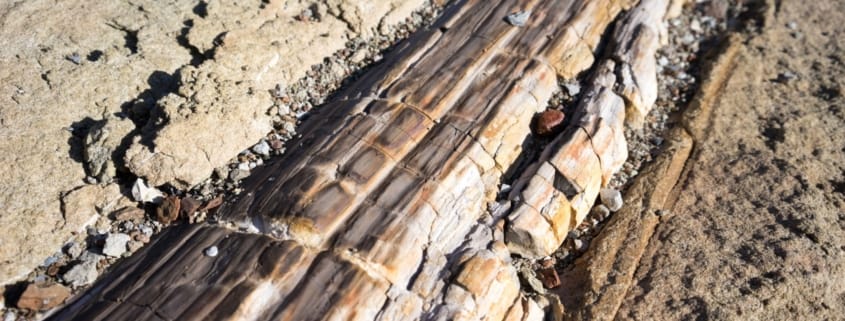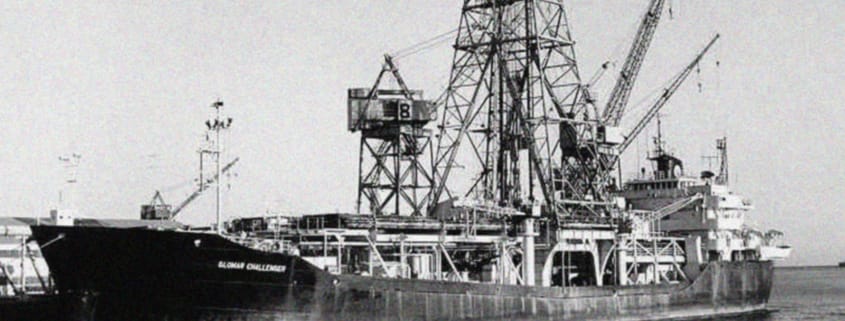Besides the ever-memorable deluges of Noah, Ogyges, and Deucalion, we have innumerable other accounts of the waters of the ocean making less remarkable encroachments on the shores at particular times and places, and returning to their former bounds. If it were necessary, a multitude of instances might be produced; though, were I only to hint at one-twentieth part of those which might be enumerated, they would far exceed the proposed bounds of the present work. Among the writings of the ancient Romans, some accounts of this sort stand recorded in Ovid‘s Metamorphoses,
“I’ve seen the solid earth transformed to sea, And water also turn to solid land, Fishes’ shells lie distant from the ocean, And rusty anchors on the tops of mountains!”
And Horace sings, that
“Fishes swam in bushy groves, Once the well-known perch of doves.”
The author of the History of the Earth and Animated Nature gives many instances confirming the same opinion, and adds that the seas being thus seen to give and take away lands at pleasure is, without question, one of the most extraordinary considerations in all natural history. In some places, he says, it is seen to gain the superiority by slow and certain approaches; or to burst in at once, and overwhelm all things in undistinguished destruction; in other places it departs from its shores, and where its waters have been known to rage, it leaves fields which soon become covered with the most beautiful verdure; and in another place, “that all this is wonderful; and perhaps, instead of attempting to inquire after the cause, which has hitherto been inscrutable, it will best become us to rest satisfied with admiration.” I have taken some pains in making a collection of all the accounts of this sort within my reach, and find that the low countries, the United Netherlands in particular, have often been overflowed: I shall at present select only three of the last which have happened in that champaign country. The first of the three was about the year of our Lord 570, when Turonens says that even the people of part of France were almost swallowed up by inundations; that Italy also suffered prodigiously, and the whole wall of Lyons was thrown down.
Secondly, Henry the First, of England, was born in the year 1068, and in his time there happened a mighty inundation, which extended to Flanders; whereby a great part of that country was irrecoverably lost, and many poor people, being bereft of their habitations, came over to England. King Henry, taking compassion on their distressed condition, and also considering that they might be beneficial to his subjects, by instructing them in manufactures, he first settled them about Carlisle, and afterwards removed them into South Wales, where many of their posterity are reported by the celebrated Ray to be remaining in his time.
About this time also, a large estate, or island, the patrimony of Earl Goodwin, containing about 4000 acres, was overflowed by the ocean, and was afterwards called the Goodwin Sands.
The last inundation of note which happened in Holland, was in the year 1446, when the sea gradually swelled, until it broke in at Dort, and drowned one hundred thousand persons, and a greater number about Dullart; two hundred villages are declared, by Ray, to have been laid under water, leaving the tops of steeples and towers visible when the tide was out.
If we only contemplate the time between these former inundations, and conceive that what has happened heretofore may also come about again, may not we then, in the approaching century, at the same place, expect the like event?
After collecting various accounts of inundations which have happened in different parts of the world, and in different ages, and after their arrangement in chronological order, there is found a very remarkable agreement between them and the periods of revolution of the magnetic points; Hence, from a variety of deductions, the following conclusions are drawn:
- That as the periodical revolution of the northern magnetic point is in even numbers, about 426 years, whenever this alone comes on the meridian of any place, it makes the ocean gradually swell to such a degree, as to overflow all low flat lands near its borders, which may be termed a magnetic tide.
- That as the periodical revolution of the southern magnetic point is about 5,420 years, when the two magnetic points are in conjunction, the ocean swells to such a degree, as gradually to cover the high grounds, which may be termed a magnetic spring tide.
- That at the times of the deluge of Noah, of Ogyges, and Deucalion, the two magnetic points, from their rate of revolution, were both near the meridian of those places where they happened respectively, and never since.
According to the best accounts, Noah’s deluge was 2349 years before the birth of Christ, and Deucalion’s deluge 1500 years before the same period. Then 2349-1500=849-426=423; and as the period of the northern magnetic point is about 426, these two deluges make within three years of two revolutions of the northern magnetic point. But the famous deluge of Ogyges happened between that of Noah and Deucalion; Ogyges was King of the Thebans, or, as some say, of Ogygia and Aste, afterwards Boeotia and Attica; he is recorded to have been the first founder of Thebes and Eleusin: some affirm that he perished with all his subjects 1796 years before Christ. In Ray’s Theological discourses, the deluge of Ogyges is said to have laid waste the country where it happened, almost two hundred years. I therefore suspect the time commonly allowed for that event is the time in which the waters abated, otherwise there would have been so little time between the deluges of Ogyges and Deucalion as not to distinguish them apart. The northern magnetic point must have been near the meridian of Athens in Greece, at the deluge of Noah, according to its rate of revolution; Athens is 24° east longitude from Greenwich, and the northern magnetic point in 1790 is 80° west from the same meridian. We have 80° + 24°=104°; then round the earth is 360°—104°=256°; likewise 360° ÷ 24 revolutions = 15°; Also Noah’s deluge before Christ 2349 + 1790=4139; then as 4139y : 3496d :: 1y : 50′ 40″ 44′′′ for its annual rate, which is found to agree with the tables to a minute.
(Then, in order to try the agreement of the southern magnetic point, according to its rate of revolution it must have been, at the beginning of the deluge of Ogyges, near the meridian of Athens, 24° east longitude from Greenwich, and in 1777 it was 140° east by calculation and the tables; We have 140°-24°=116; and the degrees round the globe 360°-116°=244° since the deluge of Ogyges. Then from the beginning of this deluge, before Christ, 1923y + 1777=3700 years; then as 244° : 3700y :: 360° : 5459 years; which agrees exactly with the tables and calculation in the last chapter, and I hope none will imagine an inconsistency with the dignity of the Deity, in acting by secondary causes in this case, as well as many others.
Diodorus Siculus, in his fifth book, gives an ancient story, current among the Samothracians, that before any other floods recorded in history there was a very great deluge that overflowed a good part of the coast of Asia, and the lower grounds of its islands, when the Euxine Sea first broke open the Thracian Bosphorus and Hellespont, and drowned all the adjacent countries.
Many of the moderns seem to think that the account of the great island of Atlantis, mentioned by the ancients, is not altogether fabulous, and that America agrees to the description thereof; it is reported to have sunk under water, at a time answerable to the two magnetic points being in conjunction on this side of the world. The most distinct account of this extensive country is mentioned in the Timaeus of Plato, according to the following abridgement. The Atlantis was a large island in the Western Ocean, situated before or opposite to the Straits of Gades (or Cadiz near Gibraltar). Out of this island there was an easy passage into some others, which lay near a large continent exceeding in greatness all Europe and Asia. Neptune settled in this island, (from whose son Atlas its name was derived) and divided it among his ten sons. To the youngest fell the extremity of the island called Gadir, which, in the language of the country, signifies fertile, or abundant in sheep. At length, the island sunk under water, and for a long time afterwards the sea thereabouts was full of rocks and shelves.
As the isthmus of Darien is so very narrow, perhaps South America itself was the island of Atlantis, and North America nothing less than that great continent described by Plato. It is true, that petrified sea shells are often found in layers on high ground, and the natives of this country have a tradition of its being overflowed. Lewis Evans, in a note in his first map of the American colonies, declares, we have glaring marks of a deluge in America of a more recent date than those of the old world. Nay, Thomas Jefferson, Esq; the Secretary of State, in his notes on Virginia, and Charles Thomson, Esq; late Secretary of Congress, in an appendix thereto, both give us very pertinent and entertaining remarks on this subject. General Lincoln, likewise, in a letter to the President of the University of Cambridge, in Massachusetts, which is published in the Memoirs of the American Academy of Arts, makes some ingenious observations pointing the same way. To these several valuable works I must beg leave to refer.
Since the Settlement of North-America, by Europeans, it is manifest that the sea has made considerable encroachments on the land; on the eastern coast of this country a multitude of evidences are visible, which agree with this hypothesis; as in Nova Scotia the stumps of trees are seen twenty feet below the common high water mark. On the banks of Delaware River, lives a poor old illiterate man, who has distinguished the highest tide which has happened every year for many years, by a notch on a tree near the shore; he has continued his observations, until his marks have mounted one above another in a surprising manner; and some men are still living in Delaware State, who have reaped wheat on grounds which are now converted to salt marsh. On Chesapeake Bay, when the lands were first surveyed, some of them were bounded by marked trees, which then stood on dry ground, and now their stumps stand under water; also, in some places, where orchards were planted near the shore, the waters have encroached to such a degree as to kill the fruit trees: at one place a burying-ground is now part dashed by the waves, which was once at a distance from the shore. In Capt. Bernard Romans‘s Natural History of Florida, vol. I. page 20, he describes a number of stumps which are only to be seen at low water; he believes them to be the remains of ancient forests, on which the sea has made an encroachment.

Further Reading
- Ovid’s Metamorphoses – A seminal work of Latin literature, containing the story of Deucalion and Pyrrha. Link
- History of the Earth and Animated Nature – A natural history book by Oliver Goldsmith covering geology and biology. Link
- Flood of Deucalion – Greek myth of a flood sent by Zeus to cleanse humanity. Link
- Noah’s Flood – The biblical deluge described in the Book of Genesis. Link
- Ogyges’ Flood – A catastrophic flood in Greek mythology predating Deucalion’s. Link
- Horace – Roman poet known for works reflecting historical and mythological themes. Link
- Diodorus Siculus – Ancient Greek historian who recorded early flood myths. Link
- Plato’s Timaeus – Dialogue mentioning Atlantis and catastrophic floods. Link
- Atlantis – The legendary lost island civilization described by Plato. Link
- Goodwin Sands – A sandbank in the English Channel, said to have once been an island. Link
- The Thracian Bosphorus – A strait mentioned in myths about catastrophic floods. Link
- Hellespont – A narrow strait linked to ancient flood stories. Link
- Lyons Flood (570 AD) – A historical flood that devastated parts of France and Italy. Link
- Henry I of England – King during a major inundation affecting Flanders. Link
- The 1446 Dutch Flood – A devastating flood in the Netherlands. Link (related flood)
- The South American Deluge – The idea that parts of South America could be remnants of Atlantis. Link
- Chesapeake Bay Land Loss – Evidence of rising sea levels in North America. Link
- Delaware River Flooding – Historical shoreline changes recorded by local observers. Link
- Petrified Seashells in the Americas – Geological evidence of past marine incursions. Link
- Ray’s Theological Discourses – Religious interpretations of natural disasters. Link
- Thomas Jefferson’s Notes on the State of Virginia – Observations on American geology and climate. Link
- Charles Thomson – Early American scholar with insights on deluges. Link
- Memoirs of the American Academy of Arts – Contains flood-related research and observations. Link











Leave a Reply
Want to join the discussion?Feel free to contribute!